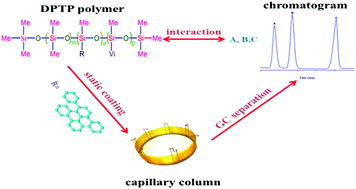1,4-Diphenyltriphenylene grafted polysiloxane as a stationary phase for gas chromatography
Abstract
In this work, 1,4-diphenyltriphenylene-grafted (14.2%) polysiloxane (DPTP) was successfully synthesized and statically coated on capillary columns as a stationary phase for gas chromatography. The DPTP columns exhibited excellent efficiencies of 3646 plates m−1 for a 30 m column and 3125 plates m−1 for a 10 m column, as evidenced by naphthalene measurements at 120 °C, which demonstrated the good film-forming ability of DPTP. Thermogravimetric analysis showed that the weight of DPTP is reduced by 2% at 380 °C. Separation of the polyethylene pyrolysis product indicated that the maximum allowable operating temperature of the DPTP column is 360 °C. The moderate polarity of the DPTP column was investigated in terms of McReynolds constants. The DPTP column was utilized to separate analytes, including aromatic isomers, fatty acid esters, ethers, polycyclic aromatic hydrocarbons and their derivatives, and nitrogenous heterocyclic compounds, on the basis of the column's strong π–π stacking, dipole-induced dipole, and dispersion interactions with solutes. In general, the DPTP column offers great potential as a novel stationary phase for separating various analytes due to its special structure and remarkable separation performance.



 Please wait while we load your content...
Please wait while we load your content...